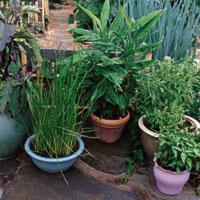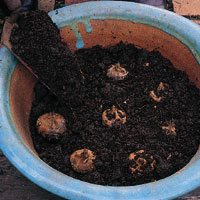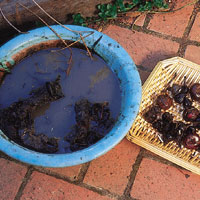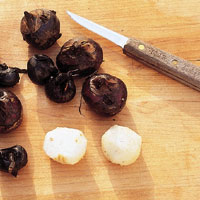





 This water garden appeals to your taste buds.
This water garden appeals to your taste buds.
You can eat the leaves of water fern, water spinach, and chameleon plant (although some find it too bitter for their taste). The leaves, tuberous roots, and seeds of lotus are mainstays in Asian cuisine. Add the leaves of water celery to soups for a mild celery flavor. Use the leaves of water mint as you would other mints. Harvest the tubers of duck potato and roast them.Watercress, the best known, requires moving water, and it is difficult to grow successfully in a pot.
You can plant water chestnuts in any shallow container that will hold water. If you plan to put them in a pond, use a container that has drainage holes in the bottom or sides. Gather the corms of water chestnuts and use them in a stir-fry or hors d'oeuvre.
Add an inexpensive, small-scale water garden using our how-to.
Zones: 4-11 Time: About 1 hour

1. Plant. Start water chestnuts in spring. Put 2-3 inches of soil in an 18-inch container that is at least 6 inches deep. Set the corms 1-2 inches apart. Cover with 1-2 inches of soil. Gently firm the soil. For a pond planting, cover with a layer of pea gravel.

2. Water. Pour water over the planting to fill the container. Always keep the water level at least 1 inch above the soil. (In a pond or bog, submerge the container so that 4-6 inches of water are above the rim.) Place the plants in full sun. Fertilize every 3 weeks with fish emulsion.

3. Harvest. Water chestnuts mature in about 6 months. When the foliage turns brown, lift the plants out of the soil. Wash off the soil and rub the foliage off the chestnuts.

4. Enjoy. To use, peel the chestnuts. Use them in stir fries or wrap with bacon and grill for a crunchy treat. Replant some of the smaller, unpeeled corms in fresh soil for next year's harvest.
Copyright © www.100flowers.win Botanic Garden All Rights Reserved